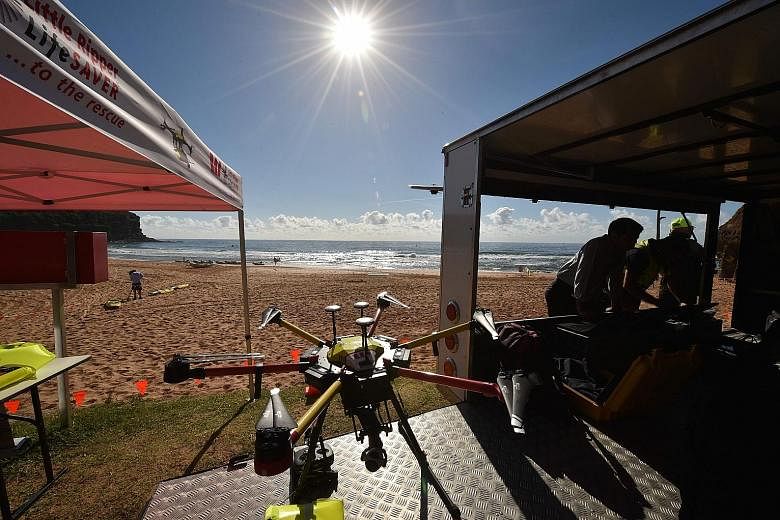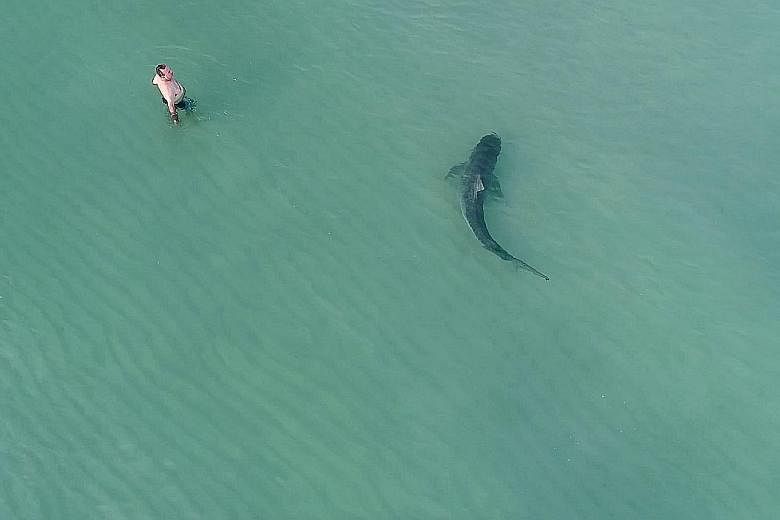For those about to swim at an Australian beach, the map of the country that appears on the Dorsal shark-tracking app may be a worrying sight.
The app, with about 250,000 users in Australia, shows numerous shark sightings dotted across the country's massive coastline. The sightings are based on reports by beachgoers as well as signals from sharks which have been electronically tagged by the authorities.
It is part of a growing effort to use new technology to try to prevent shark attacks. This follows a spate of serious bites in recent years, including several deaths.
In Perth, drones are being used for the first time to spot and monitor sharks at five beaches. Following a successful trial last year, the drones are operated by lifeguards and have already sighted several predators this summer, leading to beach evacuations.
Drones are also being used in the state of Queensland to spot sharks as well as dangerous currents.
"The more surveillance we have, the more chance we have of getting to people before they need to be rescued," a lifeguard trained to use the drone, Mr Trent Robinson, told ABC News on Wednesday. "Rescues are not what we want to be doing."
Other new technology devices include "smart buoys" which are used to detect and identify underwater creatures and send messages to the authorities who can sound alarms. Another is "shark shields", which are used by surfers and divers to transmit electric signals to avert attacks.
An expert on sharks in Australia, Professor Jessica Meeuwig of the University of Western Australia, said she opposed culling sharks and welcomed new technologies which attempted to collect and spread information. She said the best way to prevent attacks was to help people understand when and where to enter the water safely.
"Lethal approaches don't solve the problem," she told The Sunday Times. "The issue comes down to understanding the animals so that people know what the risk is. Being scared of sharks is not a great strategy - understanding them is a much better approach."
Experts are unsure of why there has been an increase in shark attacks in Australia in recent years, particularly on the west coast and in northern parts of New South Wales. Some believe warmer water temperatures may be affecting the movement and breeding patterns of sharks, or that the additional number of attacks may simply be due to an increase in the number of people entering the water.
Australia has had 47 deaths from shark attacks in the past 50 years. From 2014 to this year, there were six fatalities.
But there has long been debate about how best to prevent attacks.
The use of new technologies was endorsed by a parliamentary committee on the environment which held an inquiry into preventing shark attacks. In a report released on Dec 12, the committee said the authorities should adopt scientifically tested measures which do not involve killing sharks. "Non-lethal measures are cost-effective and enable individuals to take personal responsibility for their safety," the committee said.
"Australia could be a world leader in the development and commercialisation of new technologies."
Controversially, the committee, which was chaired by a Greens MP, said states which have shark nets at beaches should eventually remove them. It also said drum lines, or baited hooks, which are used by the state of Queensland, should be banned because they unnecessarily kill marine life.
The committee said nets have not been proven to be effective, noting that they do not cover the length of entire beaches and sharks can swim around or under them.
But some MPs in a separate report rejected the suggestion that nets had not improved safety. They said there had been just one death in 55 years at the roughly 85 beaches in Australia with nets.
The Queensland Government agreed, saying that using the nets has "undoubtedly saved lives. That's why it will continue".
Asked about these statistics, Prof Meeuwig said many of these beaches had no fatalities even before the nets were installed. "Most sharks caught in nets are on their way back from the beach (after making it past the net)," she said.
The debate about nets and other lethal methods will no doubt continue, but more surfers, swimmers and divers are embracing new, less intrusive technologies.
However, the co-founder of the Dorsal app, Ms Sarah Beardmore, noted recently that some people may not want to use it as they would prefer to enter the water without worrying about the possibility of an attack. "We do get a lot of surfers who say they'd rather not know," she told ABC News. "But it is like anything, you can either use the app or you don't."



